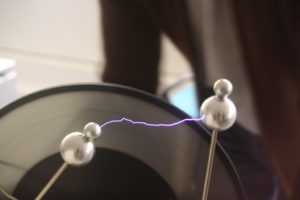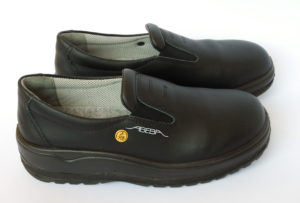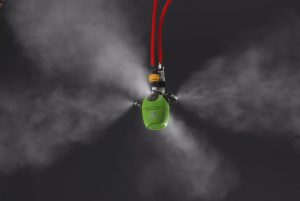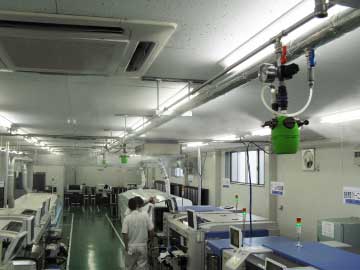February 25, 2020
Measures against conductors and insulators

Measures against conductors and insulators
With the potential for devastating explosions, taking measures against electrostatic discharge is paramount in a factory setting. Distinguishing between conductors – materials allowing electrons to move freely – and insulators where an electron flow is restricted can lessen these risks; however, further solutions are needed. Let’s take a look into tools available to guard factories from dangerous static electricity built up.
Measures for conductors
Which measures against electrostatic damages can we take when the charged object is a conductor ?
The best way to prevent electrostatic damage is to prevent the generation of this static electricity, but it is not possible.
So, actually, we use a static eliminator, such as a ionizer, to suppress the generation of electric charge and to quickly release it. This creates an electric charge of the opposite sign of the charged body and neutralizes the electric charge of the charged object.
Electrostatic countermeasures require a good understanding of the electrical properties of materials and the environment.
Grounding, wrist strap and antistatic flooring, shoes and clothing are different measures against conductors. Let’s take a closer look on these different way to prevent electrostatic discharge.
Grounding
If the object is a conductor such as a metal, “grounding” is a general countermeasure against static electricity. It is an “infinite charge absorber” and it allows electricity to escape to the ground.
Earth:
- Large conductor
- Surface of the earth is at zero potential
- Accumulated electricity is released to the earth
By grounding the charged conductor, the charge instantaneously flows to the ground and is lost.
But there is a risk that the grounding of machinery will be forgotten and that will not work due to corrosion of the grounding parts without your knowledge.

Grounding is only effective for conductors, but not for insulators such as glass or plastic.
In the case of an insulator:
- the charged charge does not move,
- remains as it is,
- and is not removed.
However, if the insulator is in contact with a grounded conductor, the static on the insulator may appear to have disappeared. But this is not the case.
The reason is the charge can move freely by grounding. When the charged insulator comes in contact with it, the surface of the conductor is attracted to the charge of the opposite polarity to the charge of the charged insulator.
So, the positive and negative poles are neutralized. It looks like as if the charge has been removed but the charge on the insulator is not moving.
When you pull it away from the conductor, you can see that the static electricity that seemed to have disappeared remains.

The wrist strap
The wrist strap is to release the potential of the human body by grounding the worker’s skin to prevent the static electricity generated from the human body from affecting the work. This wrist strap should be worn during work to prevent static electricity.

Antistatic flooring
In managing static electricity, floor electrification in the management area is a major factor that generates static electricity from people moving and equipments. There are two main types of floor antistatic management:
- the concept of antistatic, which suppresses electrification in contact with workers,
- the concept of grounding, which spreads the generated charge gently.
Antistatic shoes
As with the floor, shoes are an important point to check.
As a measure to prevent static electricity on shoes, there are:
- a method of attaching a heel strap or an ankle strap to a shoe and grounding it,
- a method of adding conductive properties such as safety shoes for preventing static electricity. The conductivity in that case depends on the structure and material.


Antistatic clothing
Even if the human body is grounded, it cannot spread the charge on clothes.
There are various types of clothing that can be used to prevent static electricity in clothing. But their characteristics are highly dependent on the humidity and temperature of the clothing.
If you wear non-static-protected clothing in the static control area, measure the generated electrostatic voltage. It is necessary to measure the resistivity and take other measures based on the characteristics.
Measure for insulators
To prevent electrostatic damages from insulators, we need to make the charged insulator material conductive. Like this, it will be easier to remove the charge by grounding the end of the material.
There are two ways to make an insulator conductive:
- making the surface of the material conductive
- adding a material with good conductivity to the material.
Surface conductivity
Surface conductivity is a common method because only the surface of the material can be made conductive so that it can be charged without damaging the properties of the original material.
It’s possible to do that:
- by covering the surface of a polymer material,
- by accelerating the leakage of electric charges by the conductivity of the metal layer,
- with carbon black or silver,
- by applying a conductive paint in which a conductive material such as particles is included in the paint,
- by accelerating charge leakage by moisture adsorbed on the surface by making the surface hydrophilic.
As a disadvantage, this prevention effect may be reduced due to cleaning or surface deterioration.
Volumetric conductivity
Volumetric conductivity is a method of making a material itself conductive by mixing a conductive material such as carbon fiber into a polymer material.
This method makes it easy to remove static electricity by grounding, since the polymer material is definitely conductive. In addition, the effect is that the material itself becomes conductive even when the surface is cleaned, so it can be said that the effect is more permanent than when the surface is made conductive.

Anti-static spray
Spray-type anti-static agents control the static electricity by applying a liquid to the material surface. Its function is to diffuse electric charge into the surrounding environment by increasing the conductivity of the surface.
The coating type anti-static agent makes the surface of the material smooth, thereby suppressing the charge due to friction.
Humidification
This is a method of increasing the surface conductivity by keeping the environment at a constant humidity, soaking the material surface with moisture. Conversely, dry air reduces the amount of water that easily conducts electricity, making it difficult for electricity to move and may cause discharge.

The humidification method generally uses a humidifier. Other methods include spraying steam and watering the work floor. However, there are problems such as a decrease in work efficiency due to the discomfort of the worker and the promotion of dew condensation, rust and mold.
Related articles
If you want to learn more about how static electricity occurs and what to do to prevent ESD, here are our compilation of articles we covered:
- Static electricity:
- Our solutions for ESD prevention:
- Case Study of an installation: Manufacturing of car audio system
How can IKEUCHI help?
As mentioned, one of the measure against conductors and insulators is humidification. It helps to prevent electrostatic damages.
IKEUCHI, thanks to our products, will be able to add moisture in the air which will increase the conductivity. Therefore, they will be no more discharge.
We’ve studied the optimal solution to prevent electrostatic discharge (ESD), by adding humidity in working environment. Our none-wetting Dry Fog humidifier offers the adequate solution for sensitive working stations.

Contact one of our engineers to assess the optimal solution to prevent ESD in your production site.
Lison HANKENNE – IKEUCHI EUROPE B.V.
